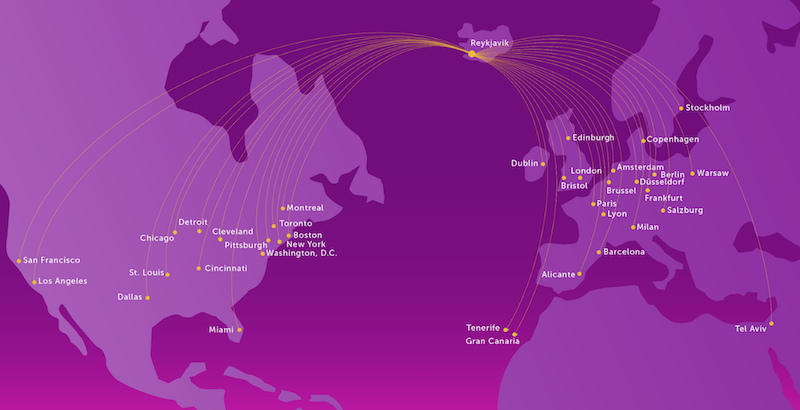Over the last few years trans-Atlantic routes have gotten cheaper thanks to discount carriers and the legacy airlines that compete with them. Norwegian has helped from not only Scandinavia but also England, Ireland, Italy and Spain to lower flight costs to Europe, but it’s flights from Iceland that are really moving the needle for travelers in North America everywhere.
If you are considering booking travel or signing up for a new credit card please click here. Both support LiveAndLetsFly.com.
If you haven’t followed us on Facebook or Instagram, add us today.
WOW Air Strikes First, Well Kind Of…
Iceland Air has been in business offering a legacy carrier alternative to major and secondary markets for many years. The problem is that while they were first, they weren’t offering the paradigm shifting prices and expansion that we have witnessed over the last couple of years. I flew Iceland Air to London almost fifteen years ago from Minneapolis and found the connection to be reasonable and the service to be perfectly fine. That was an awful long time ago though. Then came Norwegian who introduced true low-cost trans-Atlantic service but still not in the way that WOW did.
What made WOW different was primarily their operation of single-aisle A321s not typically utilized for trans-oceanic flights. Due to Iceland’s unique location and advancements in fuel efficiency these aircraft are now a preferable option over larger capacity aircraft like 757s and wide bodies for trans-Atlantic service. IcelandAir first offered connecting flights from North America to Europe utilizing Reykjavik as a hub and focusing on cities like Minneapolis, Denver, and Baltimore in addition to larger airports as well. Their 757-200s carry fewer net passengers in a three-cabin configuration (economy, economy comfort, Saga class) on less fuel-efficient 757s and were just not as competitive as WOW has been able to achieve with their A321 fleet.
WOW has been expanding left right and center over the last year. In just the last few months they added Cleveland and St. Louis, both airports where customers remember the glory days of trans-Atlantic flights direct form their home airport. They also fly A330s from the US West Coast to Iceland before connecting to major destinations in Europe (like Amsterdam and Barcelona). In just over six years they moved from predominantly East Coast major cities to secondary markets like Pittsburgh, Cincinnati and Montreal. They also have not been afraid of going against the hubs adding Miami, Dallas, Detroit, and Chicago to the map this year.

“Them Are Fightin’ Words” – IcelandAir Strikes Back
After sitting on the sidelines while WOW expanded to destinations the carrier couldn’t service with 757s like San Francisco and Los Angeles, Iceland Air started to match WOW’s deep expansion into North America. In fact the same week that WOW added four destinations to the map, IcelandAir matched them on Cleveland and other destinations in a “me too” response.
Naturally, negotiations with airports and airlines take months to progress, and both carriers were likely in discussions with the airports long before the cities were added. However, WOW seems to have the jump on new destinations most of the time. While IcelandAir has focused on markets that might be underserved by other airlines, Tampa being a great example, WOW has added more obvious markets first like Miami and Los Angeles.
IcelandAir was taking the expansion lying down for the first few years of WOW’s growth and frankly, why not? This is not the first trans-Atlantic startup that has sworn they will revolutionize the marketplace and it won’t be the last. Why adjust the business model that has been working for your company for decades to challenge some scrappy upstart? Well in the case of WOW, they took the IcelandAir model and improved upon it. It was time for IcelandAir to enter the fight and not only have they stayed with WOW blow for blow in these secondary markets, but adding Kansas City even takes the offensive.
Kansas City is Pivotal
When has expansion to Kansas City ever been pivotal? Right now. It represents more than just infrequent 757 service for middle of the road prices to Europe, it demonstrates that we have crossed the crescendo. Lucky describes the subsidies the carrier is receiving from Kansas City’s Mid Continent International (MCI) as a reason the carrier chose KC as opposed to other expansion targets but it’s not enough to lead me to believe that it really matters. Lucky points out that it amounts to just over $4,000 per flight, which barely flies the aircraft out of US airspace.
The move is pivotal because Norwegian and WOW are really the rare and limited cases. One could always suggest that the trans-Atlantic market wasn’t really changing, Norwegian was just trying to find clever ways to pilfer cash from unsuspecting casual tourists. There would be some truth in that. It’s not bold of Norwegian to fly from Europe to Los Angeles or the West Coast to Barcelona. Those routes could always absorb more capacity because they are each home to bottomless pits of paying customers.
Kansas City is not.
The metro area registers at just over 2.1MM in the combined MSA (that includes the suburbs and areas that may not be considered Kansas City proper). The city is located in the middle of the country, several hours from St. Louis by car and otherwise the sole major market before getting to Minneapolis, Dallas, or west to Denver some 500+ miles away. But the subsidy that they put together could be matched by other ambitious smaller markets. Omaha, to the north less than a three hour drive, could easily match $250,000 split over two years of service. A market like Omaha, however, might try for just weekend service and reduce their liability but offer real value to their local customer bases and the communities that surround them. Jacksonville, Milwaukee and Columbus are airports that could benefit from offering an incentive too. How is Houston not on either carrier’s route list?
Midwestern cities like Kansas City often require customers to transit three airports en route to their destination in Europe. The first will be an US hub (Chicago, Houston/Dallas, Atlanta), then their European equivalent (Frankfurt, London, Paris, Amsterdam), before their ultimate destination is reached (Prague, Marrakech, Venice). While some direct flights to these destinations may be offered via one-stop service, costs are often much more expensive than adding the connection.
Traveling from smaller cities and non-hubs just takes more time, costs more money and adds more waste. While IcelandAir is not as affordable as WOW may be, the airline will offer the first true competition to the price gouging that the alliances have been able to get away with for years. For a traveler in Boston, Europe might be a fun weekend trip, for a traveler in the midwest, it’s more of a once-in-a-lifetime experience.
While Iceland has been the focus of recent expansion, it’s really just an alternative connection point for those flying between Europe and North America. IcelandAir’s expansion into MCI, however, shows that the carrier is not waiting for WOW to validate their markets for them (as it was beginning to appear). They have leapt ahead of WOW and found a sweet spot where their 757s can still fly (it is likely out of reach for WOW’s A321 and they can’t support an A330), a larger market with business needs in Europe, and a city who will help support the expansion financially. It’s more of an example of what is possible when the process is reimagined.

A Model For The World
Other airlines are using WOW’s successful model to replicate success. Southwest Airlines originally pioneered the low-cost model by flying frequent routes with cheerful service and a single airframe type. Herb Kelleher discussed this in his book NUTS! which I highly recommend. Ryan Air, however, perfected the model. Their roll out throughout Europe has led to more than 80 bases (mini hubs) with direct flights to 33 European countries. But Ryan Air hasn’t attempted truly long haul or trans-Atlantic travel.
WOW has added a second aircraft type but fully utilized their A321 aircraft for hitting achievable markets to their north Atlantic hub in Reykjavik. While Air Asia X tried to make long haul travel work, it was less than successful and the Malaysian carrier pulled out of their London and Paris routes to focus on intra-Asian medium haul routes. Those included expansions to Beijing, Shanghai and Sydney among others.
I am careful to state that it was WOW’s expansion and not Norwegian (who still flies to Bangkok) that made further expansion viable. Air Asia X and Scoot both have flights to Hawaii started or coming soon. Scoot just announced adding Berlin to their network. Norwegian is also said to be on the verge of financial disaster but the same rumblings have not been heard about WOW.
IcelandAir’s expansion to Kansas City shows that this can work outside of the easy markets. Boston to Dublin could be flown on a 737 MAX, WestJet has been flying to Europe on single aisle aircraft from Canada’s east coast for years even before the MAX series technology. Boston to Dublin is easy. There is high interest on both the O&D business and leisure markets to fill up airplanes as you wish. New York to anywhere, DC nearly the same, but now Philadelphia, Hartford, and farther down the coast Raleigh-Durham, and Charlotte could all see competition on their European routes breaking down the barriers between the haves and the have-nots.
The “haves” should be even happier to see the low-end competition. Either the price on their hometown competing legacy carrier will come down and stay down (as we have seen in Scandinavia on both discounters and legacy US carriers) or the aircraft occupancy will drop making upgrades, and award space easier.
Whether you are on the East or West Coast, major markets or small markets, IcelandAir’s movement into Kansas City is beneficial for us all. While I doubt the Icelandic people have been dreaming of licking their fingertips to clean off homemade BBQ sauce from Arthur Bryant’s (if you haven’t done it, you should), it does open up the world for US markets where direct travel was otherwise unattainable.
What do you think about IcelandAir’s expansion into Kansas City? Is it the harbinger tipping point I suspect, or is it just a case of a carrier flying a subsidized route?




I think another key component of IcelandAir’s/WOW’s success was the marketing of Reykjavik (and the rest of Iceland) as a great stop-over as part of a longer European trip. Easy transfer to the Blue Lagoon, which of course is now all over Instagram, for short-hour stopovers; as well as the unique cuisine (puffin, whale) to appeal to the foodies, and the whole glacier/geothermal adventure-tourism for those who can spend a few days. 5-10 years ago when I was living in Boston, I’d plan my Europe trips around a Blue Lagoon stopover. I told my mom about it, and it turns out she had been doing the Iceland stopover 30 years earlier!
Singapore does this for me too as a way to start an Asian adventure, given all the great food there. However, I have yet to fly the ME3 simply because I don’t see the appeal in stopping over in Qatar or the UAE (well, maybe for a quick shwarma) – and I grew up in Saudi Arabia!
I’d love to see Dubai on a connection at some point.
The last time I was there was 20-odd years ago, so I’m sure it’s definitely built up since then! I understand the main draws now are the developments and the beaches.
In full disclosure: I actually am planning a trip on the ME3, but only as a good way to get to Oman. I like Muscat and the surrounding area far more than I ever liked the smaller island-states 🙂
Let’s see if the route makes them money first.
I think it will be somewhat successful given the limited options for Kansas City residents, price point, limited frequency and fewer available seats.
Do you think a city like Tulsa would be on their radars? Or does MCI remove any chance of that given its relative proximity?
TUL sits just far enough away from MCI, DFW, STL, XNA etc that I could see it maybe working.
Great article!
It could be, I just don’t know about traffic numbers and demand. Kansas City has a few major corporations and is the only true medium-sized city between Minneapolis and St. Louis (north to South) and remains inside the comfortable range for a 757-200. Tulsa will stretch for the distance (though you shouldn’t tell that to American which is planning to launch to Iceland with a 757 from the farther south Dallas metro). I also think the line would be a little thin for O&D traffic, but I could be wrong. Omaha is a similar metro size to Tulsa (just 50,000 in population difference and I think that most would agree that an infrequent A320NEO or 737MAX could work from a passenger number perspective, but neither have the legs (I don’t think). Then again, the limited-service 737 Stavanger-Houston route was a 737 (not MAX) and that has to be farther northeast (Scandinavia) and is certainly farther south in Houston worked for awhile. With limited cargo, I could see both cities supporting 130-150 seats weekly in an infrequent service capacity.